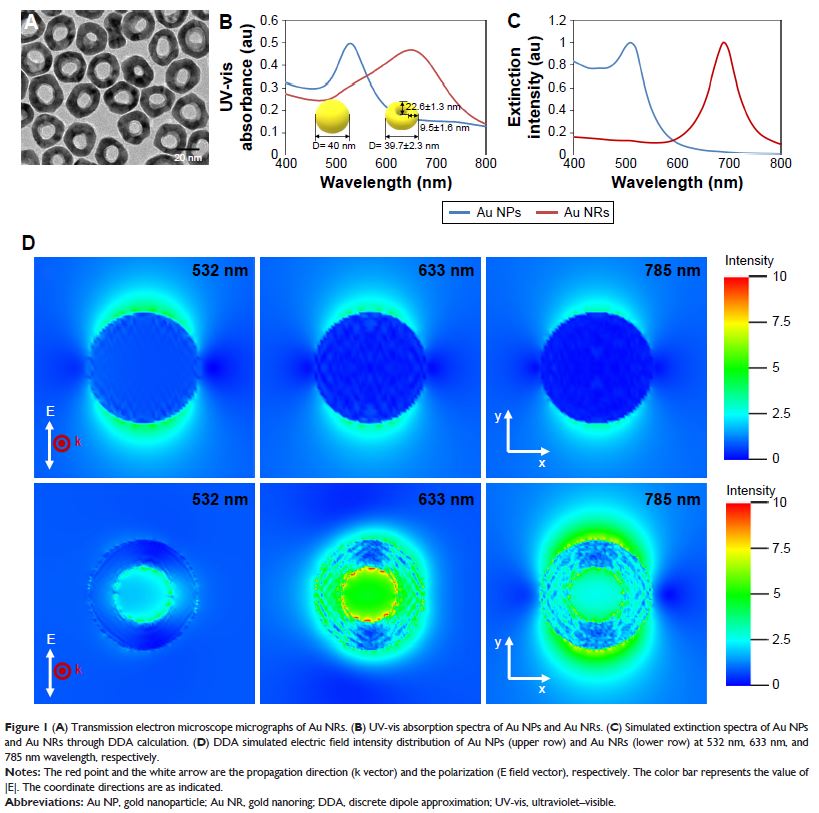108985
论文已发表
注册即可获取德孚的最新动态
IF 收录期刊
- 3.4 Breast Cancer (Dove Med Press)
- 3.2 Clin Epidemiol
- 2.6 Cancer Manag Res
- 2.9 Infect Drug Resist
- 3.7 Clin Interv Aging
- 5.1 Drug Des Dev Ther
- 3.1 Int J Chronic Obstr
- 6.6 Int J Nanomed
- 2.6 Int J Women's Health
- 2.9 Neuropsych Dis Treat
- 2.8 OncoTargets Ther
- 2.0 Patient Prefer Adher
- 2.2 Ther Clin Risk Manag
- 2.5 J Pain Res
- 3.0 Diabet Metab Synd Ob
- 3.2 Psychol Res Behav Ma
- 3.4 Nat Sci Sleep
- 1.8 Pharmgenomics Pers Med
- 2.0 Risk Manag Healthc Policy
- 4.1 J Inflamm Res
- 2.0 Int J Gen Med
- 3.4 J Hepatocell Carcinoma
- 3.0 J Asthma Allergy
- 2.2 Clin Cosmet Investig Dermatol
- 2.4 J Multidiscip Healthc

胶体等离子体金纳米颗粒和金纳米环: 形状依赖性单线态氧的产生及其在加强光动力癌症治疗疗效中的表现
Authors Yang Y, Hu Y, Du H, Ren L, Wang H
Received 7 November 2017
Accepted for publication 24 January 2018
Published 5 April 2018 Volume 2018:13 Pages 2065—2078
DOI https://doi.org/10.2147/IJN.S156347
Checked for plagiarism Yes
Review by Single-blind
Peer reviewers approved by Dr Govarthanan Muthusamy
Peer reviewer comments 3
Editor who approved publication: Dr Linlin Sun
Introduction: In recognition of the potentials of gold nanoparticles (Au NPs) in enhanced
photodynamic therapy (PDT) for cancer, it is desirable to further understand
the shape-dependent surface plasmonic resonance (SPR) properties of various
gold nanostructures and evaluate their performances in PDT.
Materials and
methods: Monodispersed colloidal spherical
solid Au NPs were synthesized by UV-assisted reduction using chloroauric acid
and sodium citrate, and hollow gold nanorings (Au NRs) with similar outer
diameter were synthesized based on sacrificial galvanic replacement method. The
enhanced electromagnetic (EM) field distribution and their corresponding
efficiency in enhancing singlet oxygen (1O2) generation of both
gold nanostructures were investigated based on theoretical simulation and
experimental measurements. Their shape-dependent SPR response and resulted cell
destruction during cellular PDT in combination with 5-aminolevulinic acid
(5-ALA) were further studied under different irradiation conditions.
Results: With comparable cellular uptake, more elevated formation of 1O2 in 5-ALA-enabled
PDT was detected with the presence of Au NRs than that with Au NPs under
broadband light irradiation in both cell-free and intracellular conditions. As
a result of the unique morphological attributes, exhibiting plasmonic effect of
Au NRs was still achievable in the near infrared (NIR) region, which led to an
enhanced therapeutic efficacy of PDT under NIR light irradiation.
Conclusion: Shape-dependent SPR response of colloidal Au NPs and Au NRs and
their respective effects in promoting PDT efficiency were demonstrated in
present study. Our innovative colloidal Au NRs with interior region accessible
to surrounding photosensitizers would serve as efficient enhancers of PDT
potentially for deep tumor treatment.
Keywords: gold nanoparticles, colloidal gold nanorings, surface plasmonic
resonance, photodynamic therapy
